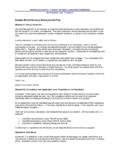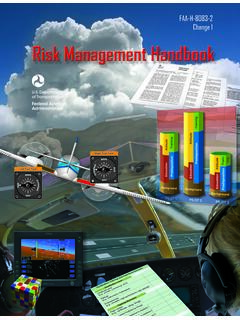Transcription of Introduction to Risk Management
1 Introduction to Risk ManagementUnderstanding Agricultural risks :Second Edition, 20131 BYLaurence Crane, Gene Gantz, Steve Isaacs, Doug Jose, Rod Sharp2 PUBLISHED BY Extension Risk Management Education and Risk Management Agency WITH FUNDING BYUnited States Department of AgriculturePRODUCTIONMARKETINGFINANCIALL EGALHUMANRisk can be defined as the chance of loss or an unfavorable outcome associated with an action. Uncertainty is not knowing what will happen in the future. The greater the uncertainty, the greater the risk. For an individual farm manager, risk Management involves optimizing expected returns subject to the risks involved and risk tolerance.
2 Agricultural producers make decisions in a risky environment every day. The consequences of their decisions are generally not known when the decisions are made. Furthermore, the outcome may be better or worse than expected. The two situations that most concern agriculture producers are: 1) is there a high probability of adverse consequences, and 2) would those adverse consequences significantly disrupt the business?Risk is what makes it possible to make a profit. If there was no risk, there would be no return to the ability to successfully manage it.
3 For each decision there is a risk-return trade-off. Anytime there is a possibility of loss (risk), there should also be an opportunity for profit. Growers must decide between different alternatives with various levels of risk. Those alternatives with minimum risk may generate little profit. Those alternatives with high risk may generate the greatest possible return but may carry more risk than the producer will wish to bear. The preferred and optimal choice must balance potential for profit and the risk of loss. It all comes down to Management , and there are no easy handbook is designed to improve the risk Management skills of American farmers and ranchers.
4 There is a broad array of established risk Management tools ready to be used and new tools are always being developed. By learning about and using these tools, crop and livestock producers can build the confidence needed to deal with risk and exciting opportunities of the future. Overview of Risk Management PlanningRisk is what makes it possible to make a profit. If there was no risk, there would be no return to the ability to successfully manage it. 1 Overview of Risk Management PlanningOverview of Risk Management in Risk Management Production Marketing Financial Legal Human in Risk Management Planning IDENTIFY risks The first step in the process of managing risk is identifying and classifying the prospective risks .
5 The five primary sources of risk are: Production, Marketing, Financial, Legal and Human. PRODUCTION RISKA gricultural production implies an expected outcome or yield. Variability in those outcomes poses risks to your ability to achieve financial goals. Any production related activity or event that has a range of possible outcomes is a production risk. The major sources of production risks are weather, climate changes, pests, diseases, technology, genetics, machinery efficiency, and the quality of inputs. Fire, wind, theft, and other casualties are also sources of production RISKM arketing is that part of a farm business that transforms production activities into financial success.
6 Agriculture operates in a global market. Unanticipated forces anywhere in the world, such as weather or government action, can lead to dramatic changes in output and input prices. When these forces are understood, they can become important considerations for the skilled marketer. Marketing risk is any market related activity or event that leads to the variability of prices farmers receive for their products or pay for production inputs. Access to markets is also a marketing RISKF inancial risk encompasses those risks that threaten the financial health of the business and has four basic components: 1) The cost and availability of capital; 2) The ability to meet cash flow needs in a timely manner; 3) The ability to maintain and grow equity;4) The ability to absorb short-term financial shocks.
7 12 Section1 The major sources of production risks are weather, climate changes, pests, diseases, technology, genetics, machinery efficiency, and the quality of in Risk Management PlanningCash flows are especially important because of the variety of on-going obligations such as cash input costs, cash lease payments, tax payments, debt repayment, and family living RISKMany of the day-to-day activities of all farmers involve commitments that have legal implications. Understanding these issues can lead to better risk Management decisions.
8 Legal issues intersect with other risk areas. For example, acquiring an operating loan has legal implications if not repaid in the specified manner. Production activities involving the use of pesticides have legal implications if appropriate safety precautions are not taken. Marketing of agricultural products can involve contract law. Human issues associated with agriculture also have legal implications, ranging from employer/employee rules and regulations, to inheritance laws. The legal issues most commonly associated with agriculture fall into five broad categories: 1) Contractual arrangements; 2) Business organization; 3) Laws and regulations; 4) Tort liability; and,5) Public policy and RISKP eople are both a source of business risk and an important part of the strategy for dealing with risk.
9 At its core, human risk Management is the ability to keep all people who are involved in the business safe, satisfied and productive. Human risk can be summarized into four main categories: 1) Human health and well-being; 2) Family and business relationships; 3) Employee Management ; and,4) Transition planning. MEASURE RISKSP robabilities are simply a way of expressing the chance of various outcomes occurring. Weather forecasts use probabilities. For example, they may indicate a 20 percent chance of rain or a 40 percent chance of snow.
10 Some probabilities are known objectively by observation or measurement. Some probabilities must be subjectively estimated by the decision maker. 23 Steps in Risk Management PlanningVariability of outcomes is generally associated with risk, and riskier situations typically have greater variability of outcomes. The average outcome is the most frequent or most likely if outcomes are normally distributed, but the average does not provide information about variability. The range, the highest and lowest possible values, combined with the average does provide some information about variability.





